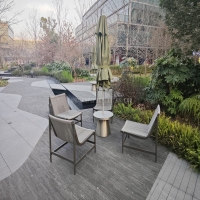Welcome to the website for landscape facilities products and knowledge.
How does the table’s design minimize the risk of water retention or pooling on its surface?
Water pooling on a table surface is more than a nuisance; it can lead to damage, staining, and a shortened lifespan for the furniture. Modern table design proactively combats this issue through a combination of intelligent engineering and material science. The primary defense is a subtle, often imperceptible, slope or tilt integrated into the tabletop. This engineered gradient is fundamental, guiding water and other liquids toward the table's edge instead of allowing them to stagnate in the center. Unlike a perfectly flat surface, this intentional incline ensures that even minor spills or rainfall are efficiently shed.
Complementing the sloped surface are strategic drainage channels or grooves. These are not always highly visible; sometimes they are discreetly incorporated into the table's design pattern or along its periphery. Their function is to capture water that is moving toward the edge and channel it away more rapidly, preventing it from spreading back across the surface. For tables with seams or joints, such as those made from multiple planks, these gaps are often part of the drainage solution, acting as natural pathways for water to escape.
The choice of material is equally critical. Non-porous materials like powder-coated aluminum, tempered glass, certain high-density plastics, and properly sealed hardwoods naturally resist water absorption. This means that water beads up on the surface, reducing its tendency to cling and spread, and making it easier for the slope and channels to do their job. Furthermore, the incorporation of rounded or lipless edges is a significant design feature. A sharp, raised lip acts as a dam, trapping water on the table. A smooth, rounded edge allows water to flow off cleanly without obstruction. Together, these design elements—the sloped plane, drainage channels, non-porous materials, and seamless edges—create a synergistic system that effectively minimizes the risk of water retention, ensuring the table remains functional, aesthetically pleasing, and durable over time.
Related search:

Recommendation
Metal structure rattan chair without armrests for single person, with woven seat and backrest.